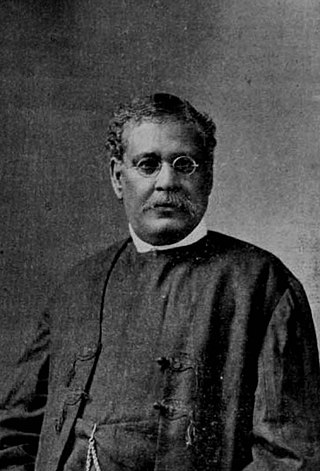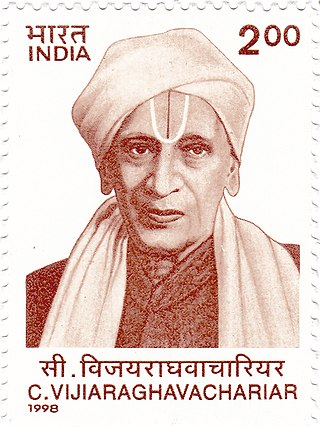
Bal Gangadhar Tilak, endeared as Lokmanya, was an Indian nationalist, teacher, and an independence activist. He was one third of the Lal Bal Pal triumvirate. The British colonial authorities called him "The father of the Indian unrest". He was also conferred with the title of "Lokmanya", which means "accepted by the people as their leader". Mahatma Gandhi called him "The Maker of Modern India".

The Indian Independence Movement, was a series of historic events with the ultimate aim of ending British rule in India. It lasted until 1947, when the Indian Independence Act 1947 was passed.

Gopal Krishna Gokhale was an Indian political leader and a social reformer during the Indian independence movement and political mentor of Indian freedom fighter Mahatma Gandhi.
The Lucknow Pact was an agreement reached between the Indian National Congress and the Muslim League (AIML) at a joint session of both the parties held in Lucknow in December 1916. Through the pact, the two parties agreed to allow representation to religious minorities in the provincial legislatures. The Muslim League leaders agreed to join the Congress movement demanding Indian autonomy. Scholars cite this as an example of a consociational practice in Indian politics. Bal Gangadhar Tilak represented the Congress while framing the deal, and Muhammad Ali Jinnah participated in this event.
The Indian Statutory Commission, also known as the Simon Commission, was a group of seven members of the British Parliament under the chairmanship of Sir John Simon. The commission arrived in the Indian subcontinent in 1928 to study constitutional reform in Britain's largest and most important possession. One of its members was Clement Attlee, who would later become the Prime Minister of the United Kingdom.

The Indian Home Rule movement was a movement in British India on the lines of the Irish Home Rule movement and other home rule movements. The movement lasted around two years between 1916–1918 and is believed to have set the stage for the independence movement under the leadership of Annie Besant and Bal Gangadhar Tilak to the educated English speaking upper class Indians. In 1920 All India Home Rule League changed its name to Swarajya Sabha.

Purushottam Das Tandon was a freedom fighter from Allahabad, Uttar Pradesh, India. He is widely remembered for his opposition to the partition of India, as well as efforts in achieving the Official Language of India status for Hindi. He was customarily given the title Rajarshi. He was popularly known as UP Gandhi. He was awarded the Bharat Ratna, India's highest civilian award, in 1961.

The first Partition of Bengal (1905) was a territorial reorganization of the Bengal Presidency implemented by the authorities of the British Raj. The reorganization separated the largely Muslim eastern areas from the largely Hindu western areas. Announced on 16 July 1905 by Lord Curzon, then Viceroy of India, and implemented West Bengal for Hindus and East Bengal for Muslims, it was undone a mere six years later. The nationalists saw the partition as a challenge to Indian nationalism and as a deliberate attempt to divide the Bengal Presidency on religious grounds, with a Muslim majority in the east and a Hindu majority in the west. The Hindus of West Bengal complained that the division would make them a minority in a province that would incorporate the province of Bihar and Orissa. Hindus were outraged at what they saw as a "divide and rule" policy, even though Curzon stressed it would produce administrative efficiency. The partition animated the Muslims to form their own national organization along communal lines. To appease Bengali sentiment, Bengal was reunited by King George V in 1911, in response to the Swadeshi movement's riots in protest against the policy.
The Liberal Party of India was a political organization espousing liberalism in the politics of India.

Lal Bal Pal were a triumvirate of assertive nationalists in British India in the early 20th century, from 1906 to 1918. They advocated the Swadeshi movement involving the boycott of all imported items and the use of Indian-made goods in 1907 during the anti-Partition agitation in Bengal which began in 1905.

Vishnu Ganesh Pingle was an Indian revolutionary and a member of the Ghadar Party who was one of those executed in 1915 following the Lahore conspiracy trial for his role in the Ghadar conspiracy.

Sir Rashbehari Ghosh was an Indian politician, lawyer, social worker and philanthropist. His house in Burdwan District is still there. His family members still reside there. The road is named as R. B Ghosh Road. A very few from next generation have joined legal profession. Many stories related to his life can be found from his biography DADAR KOTHA written by his younger brother Suresh Ghosh, he was a painter. One of his younger brothers was Justice of Calcutta High Court before independence Sir Bipin behari Ghosh.

Chakravarti Vijayaraghavachariar was an Indian politician. He rose to prominence following his appeal against the false charges alleging him to have instigated a Hindu – Muslim riot in Salem. The legal battle and eventual victory in proving his innocence earned him the title The Lion of South India.
Hindu Revolution is a term in Hindu nationalism referring to a sociopolitical movement aiming to overthrow untouchability and casteism to unified social and political community to create the foundations of a modern nation.
The Indian National Congress was formed in 1885, in 1907 it split into two faction, extremists — Garam Dal led by Bal Gangadhar Tilak and moderates Naram Dal led by Gokhale. They were termed so because of their attitude towards the British rule. The Garam Dal is considered as a triumvirate comprising apart from Tilak, Lala Lajpat Rai and Bipinchandra Pal. According to Bhatt and Bhargava, the differences between the two factions of the Congress paralyzed it, due to which "the agitation for independence ran out of steam and it remained so till the end of the first world war". The Naram Dal of the Congress helped the British in its war effort, on the other hand the Garam Dal led by Tilak and Annie Besant started the Home Rule League agitation in 1917. Asghar Ali Engineer writes that the Garam Dal separated itself from the Congress, after the differences that came to fore during the Congress session of Surat in 1907. Motilal Nehru until 1915, was a follower of the moderates, however under persuasion of his son Jawaharlal Nehru, his politics led him to join the Garam Dal.
Rambhau Mandlik was a freedom fighter and a political leader in what would later be the Indian state of Maharashtra.
The Early Nationalists, also known as the Moderates, were a group of political leaders in India active between 1885 and 1907. Their emergence marked the beginning of the organised national movement in India. Some of the important moderate leaders were Pherozeshah Mehta and Dadabhai Naoroji. With members of the group drawn from educated middle-class professionals including lawyers, teachers and government officials, many of them were educated in England.
The history of the Anushilan Samiti stretches from its beginning in 1902 to 1930. The Samiti began in the first decade of the 20th century in Calcutta as conglomeration of local youth groups and gyms(Akhra). However, its focus was both physical education and proposed moral development of its members. From its inception it sought to promote what it perceived as Indian values and to focus on Indian sports e.g. Lathi and Sword play. It also encouraged its members to study Indian history as well as those of European liberalism including the French Revolution, Russian Nihilism and Italian unification. Soon after its inception it became a radical organisation that sought to end British Raj in India through revolutionary violence. After World War I, it declined steadily as its members identified closely with leftist ideologies and with the Indian National Congress. It briefly rose to prominence in the late second and third decade, being involved in some notable incidents in Calcutta, Chittagong and in the United Provinces. The samiti dissolved into the Revolutionary Socialist Party in 1930.
Assertive (Extremists/Aggressive) Nationalism was the period (1905–1916) in success to Early Nationalists or Moderates. The Early Nationalists failed to attain their objectives, giving rise to Extremist/Assertive Nationalism. The Last and final years of the nineteenth century saw the radical sensibility emerge among some Indian intellectuals like Lala Lajpat Rai, Bal Gangadhar Tilak and Bipin Chandra Pal. They all were together known as Assertive Nationalists. They rejected the former notions of the moderates of prayers, petitions and protest or the 3P's. Instead, they began adopting aggressive measures like Swadeshi and Boycott and openly accused British for the 'economic crisis of India' and for gaining freedom from the British rule in India. They played a key role in the independence of India
Pandit Neki Ram was an Indian politician. He was a Member of Parliament, representing Haryana in the Rajya Sabha the upper house of India's Parliament as a member of the Indian National Congress.









